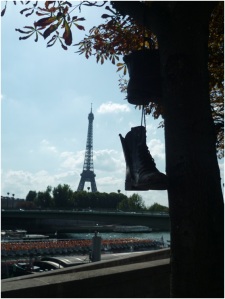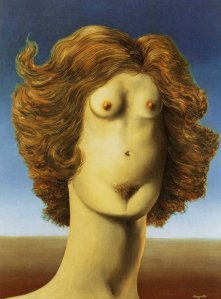Photography, Fiction and Place
This wasn’t staged. Someone had tied a pair of heavy duty boots to a tree at the intersection of the 16th and 8th arrondissements, and let them dangle like two poetic apostrophes in the air. I thought – and think now – of what happens when I snap. Susan Sontag suggests that a photograph is a violation of a subject or object’s sensibility, a “soft murder”.[1] Curiously, it is not a sexually interrogative act: photography, she says, does not rape; or, it does not actively seek to get closer to a subject, but further away. It reminded me of a little elision in both painting and language suggested by the Surrealist artist René Magritte, Le Viol (1934). Magritte transposes a highly sculptural looking female nude on to a supposedly feminine face. The point here is that Le Viol translates as The Rape, and is also the root of “violate” in English. Sontag’s humanist stance means that she does not want to give too much agency to the object in fashioning its own history outside of a cohesive sense of a distinct human subject.[2] She wants to sit in a particular position of judgment over photography so that she can negotiate and weave her way through the chaotic assemblage of the photographic order with her agency intact. The rape to which Magritte refers is one actively in the making on the surface of things; of how appearances are the material currency of always somewhat hazy desires. Photography – and the possible histories one can think to write of it – can be seen as somewhat similar. Like Magritte, I was attempting to play with the surfaces of our representations: notions of international love in romantically charged Paris intermingle with the history of France, Empire and the gigantic metal penis that was used to celebrate it, to laud over its possessions. Because the surface of the photograph does not correspond to the structure of the space it represents, there is the possibility to think with a whole infrastructure that might sit between it, and not be immediately obvious to either practitioner or observer. Was I not, after all, simply producing a photograph of my weary feet, after months of pounding the streets of Paris, looking for something? And therefore, does photography not also produce creative fictions in the place where we would usually expect to see only what Roland Barthes calls the “absolute Particular”?


Leave a comment